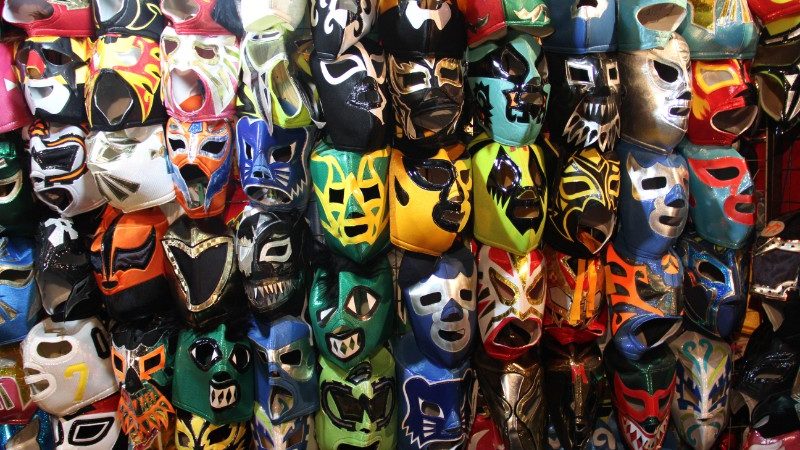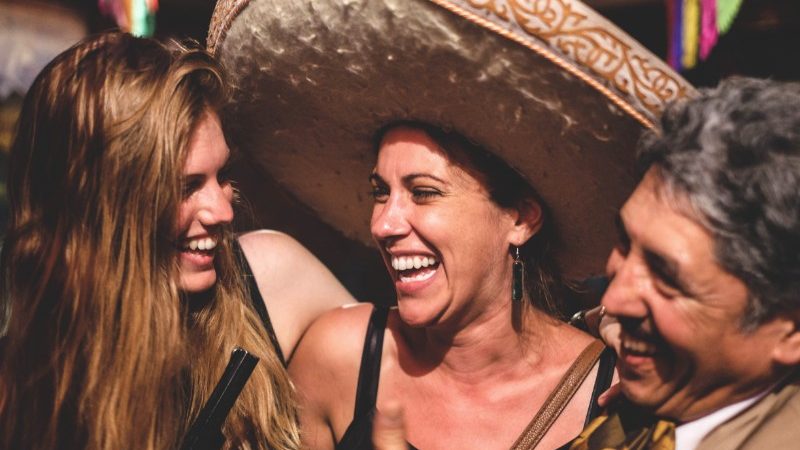My throat was raw from all the screaming, face flushed from all the beer. I was on my feet, waving my arms like a banshee and shouting in Spanish with the rest of the crowd.
Rewind two hours and I was reluctant to even board the metrobús that would take us to Arena México. “It’s just not my thing,” I protested to my friends who weren’t interested in my objection. The alternative was to stay in alone and develop an intense case of FOMO. So, I sucked up my anxiety, squished into the bus with what felt like the entire neighbourhood and off we went to Colonia Doctores.
As we edged closer to the arena, more and more people appeared. By the time we got off the metro and headed for the ticket booths, the once smattering of people had morphed into a thrumming crowd. There was reggaeton music pumping from nowhere in particular and loud Spanish announcements rang out over the speakers, promoting the upcoming fights. The street was lined with gaudy stalls, each selling hundreds of lucha libre masks of all colours and shapes (like the ones pictured at the top of this article). The sight of it all, coupled with the smell of tacos al pastor emanating from the dozens of food stands was a fiesta for the senses. With every laugh and dance, my body relaxed and by the time we entered the stadium, I was just as hyped as the rest of the masses.
Lucha Libre is a tradition with roots dating back to the 19th century. There are several conflicting stories about the origin of the sport; some point to the French Invasion of 1863, while others claim the ‘free fighting’ style was invented by Mexican wrestler Enrique Ugartechea based on other combat traditions around the world. Regardless, it wasn’t until the early 1900s and the beginning of the Mexican revolution, that it grew in popularity across the nation.
Early iterations of lucha libre had a lot more followers than they did rules. Given that fights were extremely violent and often ended in severe injury, it’s fair to say that becoming a luchador was not for the faint-hearted. In 1933, Salvador Lutteroth Gonzales came onto the lucha libre scene after becoming fascinated with wrestling in the United States. Eventually, he returned to his native Mexico and formed the Empresa Mexicana de Lucha Libre AKA the Mexican Wrestling Organisation and the modern, regulated, mask-and-costume-laden sport was born. A few years later, the sport started growing in popularity thanks to the invention of television. Enter: Santo, El Enmascarado de Plata (Saint, the Silver Masked Man). In his 1942 debut, he defeated seven other well-known luchadores to win a ‘battle royal’. Followers of the sport were immediately intrigued by the mysterious silver-masked fighter. Throughout his fifty-year career, he appeared in comic books and dozens of movies, always sporting his token silver mask. It wasn’t until his retirement in 1984 that he finally removed his máscara and revealed his identity to the public. To this day, Santo remains one of the most-loved icons in Mexican pop-culture and certainly lucha libre history.
WANT TO TRAVEL TO MEXICO? CHECK OUT OUR RANGE OF SMALL GROUP TOURS
These days, a lucha is more like a scene straight out of a telenovela than it is a genuine contest. Each battle revolves around the general concept of técnicos (good) versus rudos (bad) and is complete with garish Lycra outfits and matching masks. Rounds frequently feature appearances by female luchadores, exóticos (think: wrestlers in drag) and los minis (dwarves) who all give the traditional male fighters a run for their pesos.
There’s a reason nobody ever claimed lucha libre to be politically correct.
While the fights are choreographed, the participants are genuine athletes who are widely respected for their aerial abilities and extravagant moves, in contrast to the more modest fighting techniques seen abroad.
The Rules
Two or more wrestlers enter the ring and try to pin their opponent(s) down for three seconds, across three rounds. They’ll have their mask ripped off and competitors risk losing respect from the audience and their all-important masculinity.
“¡Qué idiota!” A shrill voice yelled next to me and I turned to see a young Latina girl pointing at the ring and laughing with her father. I just shook my head and sipped my comically-large cup of beer. At Arena México, everyone is encouraged to participate in the heckling action. After a few rounds, I was getting into the spirit too. But despite how vocal the crowd had been to this point, nothing prepared me for the roar that erupted when a bottle-tanned, blonde-haired wrestler entered the arena, decked out in stars and stripes and waving an American flag. I soon learned that nothing could rile up a crowd quite like the personification of America being beaten by a patriotic Mexican underdog.
It was chaotic, loud and probably one of the best nights of my life. So much so that a friend and I ventured back to the wrestling, this time in Jalisco, for more action. And if I thought the crowds in the capital city were wild, they had nothing on their compatriots to the west. Our seating section in Guadalajara (known affectionately as the pobre or ‘poor’ section) had a legitimate cheer-squad, complete with a six-piece band.
RELATED: THE SURPRISES AND DELIGHTS OF VISITING MEXICO CITY
Where?
In Mexico City, the main venue of lucha libre is known as Arena México and is bustling with people, irrespective of the day of the week. Several other venues also host regular luchas throughout the city. If you’re planning a longer trip around Mexico, I wholeheartedly recommend heading to the wrestling in another state; the crowds may not be as big, but I promise they’re just as passionate and tickets will almost certainly be cheaper.
SUBSCRIBE TO INTREPID’S NEWSLETTER FOR TRAVEL TIPS, STORIES, OFFERS, GIVEAWAYS & MORE
How to get there?
Technically, you can take the metro, however unless you’re with your local leader or group, I wouldn’t recommend it as the area surrounding the venue isn’t particularly safe. If you’re looking for a low-stress experience, you can always book an Urban Adventure and the transport and ticket will be arranged for you.
How much?
If you’re on an Intrepid trip, tickets to lucha libre might be included in your itinerary, so be sure to check that out first. Otherwise, if you’re watching luchas on a free day, tickets at Arena México can be purchased at the door and sell for as little as AUD10. The ticket price changes depending on your desired seating area, with spots close to the ring being the most expensive.
Do you want to experience lucha libre in Mexico? Join an Intrepid small group tour or book an Urban Adventure and you can!
Hero image by bmszealand via Shutterstock.






